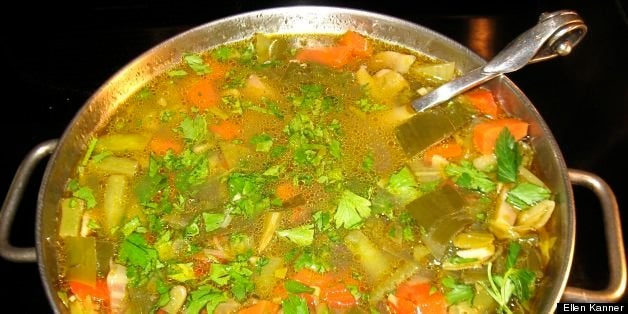
New York Times bestselling cookbook author, Cooking Channel star and the Times' lead food columnist Mark Bittman wrote the book on "How to Cook Everything Vegetarian." In his new book, "VB6," he takes on a real challenge -- how to get people to "eat well, live healthy." Terrific. But what does that mean?
"Unprocessed plant foods -- whole grains, legumes, fruits and vegetables -- a diet heavy in those things and light is everything else." Funny, it sounds vegan. Bittman says otherwise. "I'm not going to be vegan. I never said I was going to be vegan." And yet he eats vegan most days. VB6 stands for vegan before 6 p.m. and it's a formula based on one Bittman created for himself six years ago.
Up to that point, Bittman cooked and ate everything -- it was all part of the job. As a longtime runner, he felt assured his activity level and metabolism would take care of everything. But over time, his weight and cholesterol climbed enough to worry not only him but his doctor, who diagnosed hims as being prediabetic. Something had to change. Bittman changed how he ate. He began following a vegan diet during the day, adding meat at dinner if he wanted it.
What he missed during the day wasn't meat, it was white food, simple processed carbohydrates like pasta or bread, which the body breaks down into sugar. "Doing without them can be really difficult," he admits. "Whole grains are definitely a change from white food, but it's the change we need. They're slower to digest and spread their energy over a longer period of time."
He dropped the weight and the cholesterol, but hasn't dropped VB6. It's not a diet, it's not a program, it's not -- hallelujah -- a packaged meal plan. "It's a road map, a strategy that's worked for me, has worked for others. Americans tend to see things as black and white, right and wrong. This is not that kind of struggle," he says. "This is about doing somewhat better. If your diet improves ten percent, if you eat two fewer cheeseburgers a week and two more salads, that's a big deal."
The first half of the book details the VB6 how-tos, including cooking at home as much as possible. Why? "The whole food system is kind of a wreck. It's encouraging us to eat badly. Cooking gives you control over what you eat," says Bittman. "If you refuse to cook, don't want to cook, there's nothing I can do about it. You're going to have to figure out a different way to eat well. It won't be as easy." A self-taught cook, Bittman aims to make it easy. The second half of "VB6" offers recipes to take you through the days and nights. They're not fancy, they're doable, adaptable and created with Bittman's hallmark no-nonsense approach.
Bittman's been writing about food since 1980, long enough to know "there's no reason to believe you and I are going to eat the same way. There's differences in age, gender, where you eat and where you work, whether you cook, whether you travel, all of that effects how you eat."
Compared to "How to Cook Everything Vegetarian," with close to a thousand pages, 288-page "VB6" is lean and mean, not unlike Bittman himself these days. On the other hand, he's not a saint and doesn't expect you to be one, either. "If it's a bowl of white rice or bread you're craving, I don't think that is a big deal. If there's a food people don't like to eat, they shouldn't eat it. This is not an either/or proposition, that's what I like about it."
He still loves food, he still eats meat, just less frequently and less of it. "For the last two nights, I had shaved Brussels sprouts with pasta, and then chopped kale with pasta. I don't think I would have eaten either of those things five years ago."
So what's for dinner tonight? "I'm not saying I don't eat meat," Bittman insists. "But maybe a salad and vegetable soup."
Easiest Vegetable Soupfrom Mark Bittman's "VB6," copyright 2013, reprinted with permission from Clarkson Potter.
Make this with just about any vegetable you want -- really. I like a combination of longer-cooking firm vegetables and quicker-cooking soft ones, but suit yourself. For that matter, you don't even need to use a combination of vegetables; if you like, just pick one or two (you're aiming for about 6 cups of vegetables overall), bearing in mind that beans, corn, or peas will add texture and body, making the soup more satisfying.
3 tablespoons olive oil
1 large onion, chopped
1 tablespoon minced garlic
1/4 cup tomato paste
1 teaspoon salt, plus more to taste
Black pepper to taste
6 cups vegetable stock or water
3 cups chopped firm vegetables (like carrots, winter squash, cauliflower, broccoli, or root vegetables)
3 cups chopped soft vegetables (like zucchini, bell peppers, green beans, or any greens)
3 cups cooked or canned beans, or fresh or frozen corn kernels or peas
1/2 cup chopped fresh basil, for garnishPut the oil in a large pot or Dutch oven over medium-high heat. When it's hot, add the onion and garlic. Cook, stirring occasionally, until they begin to soften, 3 to 5 minutes. Stir in the tomato paste and cook until it dries out a bit, a minute or two. Sprinkle with salt and pepper.
Add the stock or water and scrape up any bits on the bottom of the pan. Add the firm vegetables.
Bring to a boil, then adjust the heat so the mixture bubbles gently. Cook, stirring once in a while, until the vegetables are quite soft, 10 to 20 minutes, depending on the kinds you're using.
Add the zucchini or other soft vegetables, along with the beans, corn, or peas. Return to a boil, then lower the heat so the mixture bubbles gently. Cook, stirring once in a while, until everything is quite soft and the soup begins to thicken, another 10 to 15 minutes. Stir in the basil, taste and adjust the seasoning, and serve.
Serves 4.
